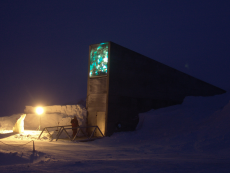
The Svalbard Global Seed Vault is a seed vault on the Norwegian island of Spitsbergen, in the Svalbard archipelago, which stores duplicates of samples from seed banks all around the world. These are banks which store seeds as a source for planting in case the species is destroyed elsewhere, through natural disasters, diseases or war. These are often food crops but could be other rare plants to protect biodiversity. The Svalbard vault preserves copies of these samples, from different seed banks in almost every country in the world. It acts as a back-up, so that the destruction of any individual seed bank would not mean that a sample was lost forever.
Construction of the vault began in 2006, with the prime ministers of Norway, Sweden, Finland, Denmark and Iceland laying the first stone on the 19th June. The vault is situated 120 metres inside a sandstone mountain and guarded by robust security systems. The location was chosen due to the lack of tectonic activity, so there is little to no chance of earthquakes damaging the samples, and it is 130 metres above sea level to prevent any risk from flooding. Locally mined coal provides power for refrigeration units which keep the samples at -18˚C. However, the permafrost surrounding the vault aids the preservation of the samples, and if the refrigerators fail the samples could still survive for several weeks. The samples are packaged in special four-ply packets, which are then heat-sealed to exclude any moisture.
The vault was officially opened on the 26th February 2008. A study conducted before construction began suggested that the vault could preserve most major food crop seeds for hundreds of years, though some samples might last for thousands. The vault has the capacity to store 4.5 million seed samples, each averaging 500 seeds—it could therefore store 2.5 billion seeds! Currently it holds 860,000 samples, from almost every country in the world, and therefore has the most diverse collection of food crop seeds in the world. Food crops are given priority for storage in the vault as these are essential to human survival.

The Svalbard vault was started by conservationist Cary Fowler, in association with the Consultative Group on International Agricultural Research (CGIAR). It is managed under an agreement between the Global Crop Diversity Trust, the Nordic Genetic Resource Centre (NordGen) and the Norwegian Government. The latter entirely funded the vault’s $9 million construction. In Norway, government-funded construction projects exceeding a certain amount must include art-work: the Svalbard vault has an illuminated light work (pictured) by artist Dyveke Sanne running the length of its roof and down the front face.
Norway and the Global Crop Diversity Trust pay for all the operational costs, with funding for the Trust coming from global governments and from organisations such as the Bill and Melinda Gates foundation. Storing seeds in the vault is free for users, and ownership of the seed samples remains with whoever made the deposit. These samples can be withdrawn at any time; the most frequent reason for withdraws would be from other seed banks being mismanaged, suffering from accidents or equipment failures. However, more extreme reasons could be from natural disasters or from war or civil strife. The first withdraw from the seed bank took place recently, when scientists from a seed bank in Aleppo, withdrew their back-up samples following the devastation of their own bank due to the ongoing conflict in Syria.
Images: https://www.regjeringen.no/globalassets/departementene/lmd/svalbard-globale-frohvelv/seed-vault_logo1_eng-300.jpg?preset=onecolumn&v=1736109548
https://www.regjeringen.no/globalassets/upload/lmd/kampanjesvalbard/bildearkiv/dsc02363_2_f_mari_tefre.jpg

0 Comment:
Be the first one to comment on this article.